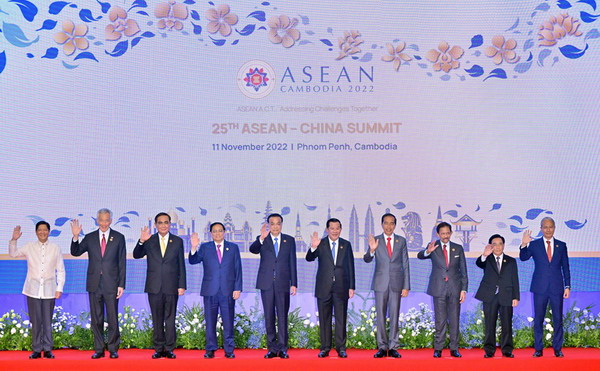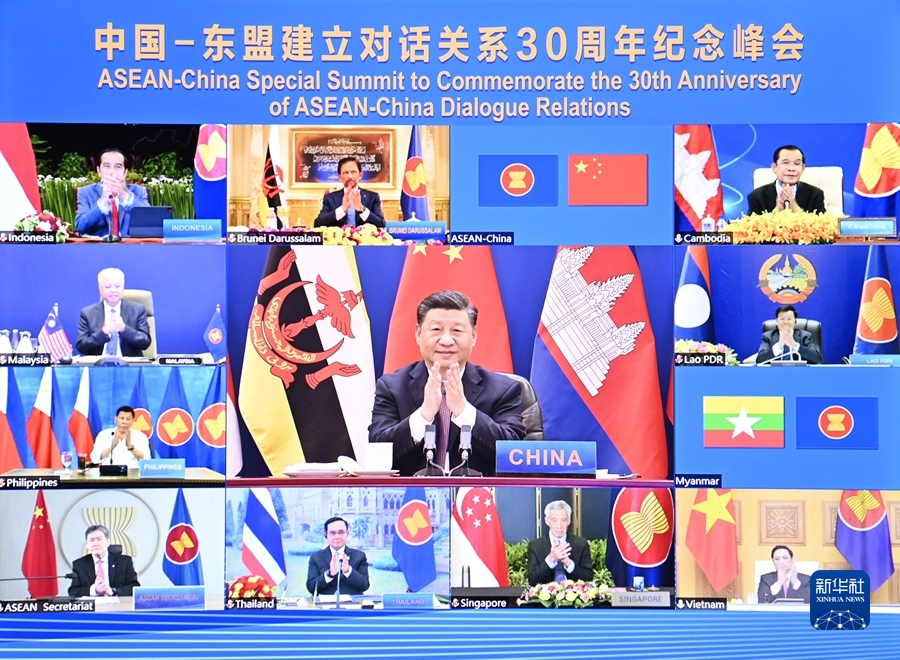|
Excellency, Mr. Gita Wirjawan, Former Minister of Trade of Indonesia,
Excellency, Ambassador Noel Servigon, Permanent Representative of the Philippines, Country Coordinator of ASEAN-China Relations and all other CPR Ambassadors,
Excellency, Ambassador Dino Patti Djalal, Founder of Foreign Policy Community of Indonesia,
Experts from China and ASEAN Member States,
Colleagues and friends,
Good morning! I extend my warm welcome to you all for joining us at the third virtual Jakarta Forum in 2020. Since its inauguration in early 2019, the Jakarta Forum has focused its discussions on important issues of China-ASEAN relations and East Asian cooperation, which is conducive to the stability and development of our region. This year, we’ve held the Forum twice via video link, with the first on regional cooperation against COVID-19 and the second on ASEAN-China blue economic partnership. Today we’re having the third one under the theme of reinforcing regional economic recovery, which is the most pressing and relevant issue for our region today.
Thanks to the joint efforts of regional countries, the pandemic in our region is generally under control. Most countries have started to shift their main focus from pandemic control to economic recovery. Building upon the close China-ASEAN cooperation on pandemic control in recent months, we are also leaning toward regional economic recovery. Once again, ASEAN-China cooperation leads by example in the region and beyond in containing the virus and boosting recovery. Let me share with you the most important episodes of recent China-ASEAN cooperation:
First, China and ASEAN leaders provide strategic guidance through strengthened communication. President Xi Jinping, Premier Li Keqiang and State Councilor and Foreign Minister Wang Yi have maintained close communication with their respective ASEAN counterparts as well as ASEAN Secretary-General, setting course for our cooperation in this time of difficulties. Fortunately, China resumed face-to-face diplomacy with ASEAN in recent months. Director Yang Jiechi of the Office of Central Commission for Foreign Affairs visited Singapore and Myanmar. State Councilor and Foreign Minister Wang Yi received Indonesian Foreign Minister Retno Marsudi, Indonesian President’s Special Envoy Luhut Pandjaitan and Philippine Foreign Secretary Teodoro Locsin and paid visits to Cambodia, Malaysia, the Lao PDR, Thailand and Singapore. These exchanges deepened our communication, boosted confidence and injected impetus in economic recovery. ASEAN-China Foreign Ministers’ Meeting in September also sent a strong signal of our commitments to jointly leading regional cooperation against COVID-19 and promoting economic recovery.
Second, China and ASEAN have promoted resumption of work and production to boost regional growth. China has established “fast lanes” and “green lanes” with Singapore, the Lao PDR, Cambodia, Myanmar and Indonesia to facilitate the movement of personnel and people, connecting the lanes into a regional network and resumed direct flights with several ASEAN countries. These efforts aim to stabilize regional production and supply chains, cultivate new growth models and business forms and thus inject stronger momentum in economic growth of regional countries.
Third, China and ASEAN have maintained resilient trade ties. It’s encouraging to see that ASEAN-China trade grew robustly despite the pandemic. ASEAN has stayed as China’s largest trading partner through the year. In the first three quarters, ASEAN-China trade reached 481.8 billion US dollars, accounting for one seventh of China’s foreign trade. It grew by 5.6 percent in the second quarter and 7.7 percent in the third quarter, much faster than that between China and other trading partners. It’s worth noting that trade between China and Vietnam even soared by 23.5 percent in the third quarter. This year, China has already made 10.7 billion US dollars of direct investment in ASEAN countries, up by 76.6 percent. These figures demonstrate the strong resilience and full potential of China-ASEAN economic relations.
Fourth, China and ASEAN have worked more closely on Belt and Road projects. China and ASEAN countries have steadily pushed forward high-quality BRI projects and created more synergy between the BRI and MPAC 2025 by overcoming difficulties brought by the pandemic. These joint endeavors are conducive to local economic recovery. The construction of China-Laos Railway moved forward rapidly, with all of the 75 tunnels drilled through and multiple stations about to complete. Regarding the Jakarta-Bandung highspeed rail, construction has started in 229 of all the 237 project sites, with two major continuous beams completed and Tunnel No. 10 traversing an existing railway line recently, marking another breakthrough. The Phnom Penh-Sihanoukville Expressway project has been going on smoothly, with over a quarter of the construction finished. China has also reached important consensus with ASEAN countries on accelerating major projects, including the China-Thailand Railway and Malaysia’s East Coast Rail Link.
Colleagues and friends,
Faced with the severe impact of the pandemic and complex developments in the region and beyond, China has made utmost efforts to coordinate pandemic control with economic and social development, enabling the Chinese economy to bounce back. China’s economy returned to a growth of 3.2 percent in the second quarter and further up by 4.9 percent in the third quarter. All the major economic indicators are turning for the better. A few weeks ago, during China’s “golden week” National Holiday, 630 million people traveled domestically. China’s retail and restaurant sales totaled 1.6 trillion yuan (about 240 billion US dollars), demonstrating the strong economic vitality. Many international economic institutions expect China to be the only major economy with positive growth in 2020.
Having taken into full consideration the economic outlook at home and abroad, the Chinese government puts forward a new development pattern of “dual circulation” that takes the domestic market as the mainstay and allows domestic and foreign markets to be reinforcing. As President Xi Jinping pointed out at the conference in celebration of the 40th anniversary of the Shenzhen Special Economic Zone weeks ago, China will promote high-quality development and build a new system of an open economy at a higher level. The domestic market will be further expanded and more closely connected with the international one, thus creating more opportunities of cooperation between China and others.
Last week, the Communist Party of China had its 19th CPC Central Committee's fifth plenary session and adopted the 14th Five-Year Plan (2021-2025) for National Economic and Social Development and the Long-Range Objectives Through the Year 2035, charting the course for China's development in the next 15 years. It further boosts the confidence of the world on China’s growth and development.
As China’s close neighbors and partners, ASEAN countries are in the best position to draw momentum from China’s new development pattern. I’m confident ASEAN will seize this opportunity and see economic recovery at a faster pace.
Colleagues and friends,
Together we are turning the pandemic crisis into opportunities, instead of allowing it to hold our relations back. China will strengthen coordination with ASEAN to adapt to the possible long-term pandemic prevention and control, advance regional economic recovery and build a closer China-ASEAN community with a shared future. I believe the following could be priorities on our future cooperation agenda:
First, we need to strive for the final victory over COVID-19. China’s experience proves that economic recovery can be speedy only when the pandemic is fully under control. Unfortunately, COVID-19 is still raging in some parts of the world and there might be a second wave of infections. We should not take the situation lightly, but rather strengthen our joint capacities on prevention, control, diagnostics and treatment, and strengthen cooperation in research, development, production and application of the vaccines. As one of the global frontrunners in vaccine development, China has four candidate vaccines in Phase III trials abroad, including Indonesia. China recently joined COVAX, the global COVID-19 vaccine facility. China will earnestly fulfill its commitment of making vaccines a global public good, once they are successfully developed and available for use. We will take the needs of ASEAN and other developing countries into consideration on a priority basis and help ASEAN prevail over the pandemic.
Second, we need to further synergize our development strategies. China looks forward to deepening BRI cooperation with ASEAN, better synergize the development of the Guangdong-Hong Kong-Macao Greater Bay Area with the New International Land-Sea Trade Corridor and advance regional connectivity projects. China will prioritize ASEAN in expanding the scale of currency swaps, expand the “fast lanes” and increase the number of commercial flights. China attaches importance to ASEAN’s aspiration for economic recovery, fully supports the ASEAN Comprehensive Recovery Framework and Implementation Plan and stands ready to explore cooperation accordingly.
Third, we need to cultivate new areas of growth. New prospects of cooperation are opening in the ASEAN-China Year of Digital Economic Cooperation in 2020 and the ASEAN-China Year of Sustainable Development in 2021. There is much more that could be done between China and ASEAN in emerging industries, such as digital economy, smart manufacturing, 5G, big data and smart cities. Together we could also explore an ASEAN-China partnership on blue economy. ASEAN countries are expected to strengthen industrialization capacity and competitiveness in core areas, thus making most of the opportunities in the fourth Industrial Revolution.
Fourth, we need consolidate regional consensus on multilateralism. As this year marks the 10th anniversary of the ASEAN-China Free Tree Agreement (ACFTA), China and ASEAN will jointly implement the Upgrading Protocol of the ACFTA. China will host the International Import Expo and China-ASEAN Expo this month, and we are working on more import of agri-products from ASEAN, such as rice, palm oil and tropical fruits. To move our ties forward, it’s important to champion our Asian values of solidarity and collaboration, support the ASEAN-centered regional architecture and uphold multilateralism and win-win cooperation. In the meantime, it’s also critical for us to oppose power politics and unilateral bullying, uphold the global free trade system and work towards the signing of the Regional Comprehensive Economic Partnership (RCEP) within this year.
Colleagues and friends,
A review of history shows that crises have never been absent for China and ASEAN, be it the Asian financial crisis, the international financial crisis, SARS or H5N1 influenza. However, China and ASEAN have withstood every test of the times, and our relations only emerged closer and cooperation stronger. Next year marks the 30th anniversary of ASEAN-China dialogue relations. I believe our valuable cooperation against the virus and on regional economic recovery will usher China-ASEAN relations to an even higher level.
I thank you.
|











